5JSC/RDA/Full draft/CCC response February 3, 2009 1 To: Joint ...
5JSC/RDA/Full draft/CCC response February 3, 2009 1 To: Joint ...
5JSC/RDA/Full draft/CCC response February 3, 2009 1 To: Joint ...
You also want an ePaper? Increase the reach of your titles
YUMPU automatically turns print PDFs into web optimized ePapers that Google loves.
<strong>5JSC</strong>/<strong>RDA</strong>/<strong>Full</strong> <strong>draft</strong>/<strong>CCC</strong> <strong>response</strong><br />
<strong>February</strong> 3, <strong>2009</strong><br />
4<br />
within an element on the source (for example, colon, slash or an equals sign) may<br />
be confused with ISBD punctuation. Could this be addressed?<br />
*1.9.2.6: Probable Decade, 1.9.2.9 Probable Century - "1900s" does not<br />
distinguish between a probable decade 1900-1909, or the probable century 1900-<br />
1999. Similarly, "2000s" could designate 2000-<strong>2009</strong> or 2000-2099. In addition,<br />
adding an s to a date to record a probable decade or century does not work in<br />
other languages. In support of internationalization, <strong>CCC</strong> supports reverting to the<br />
AACR2 convention of recording probable dates.<br />
*2.1.2.2: It is not clear if a label on a sound recording, or a title page on a book,<br />
identifying only the individual contents of the resource would qualify as a “source<br />
of information identifying the resource as a whole.” The cause of this uncertainty<br />
is the fact that the second paragraph seems to address only cases where the<br />
individual contents appear on separate sources. The example given is that of a<br />
videodisc with separate sources for each of the films contained in it and the<br />
instruction itself uses “sources of information” in the plural only (“treat the<br />
sources of information identifying its individual contents”) as if the possibility of<br />
having the individual contents identified on a single source was not considered.<br />
If a single source identifying the individual contents of a resource would not<br />
qualify as a “source of information identifying the resource as a whole,” it would<br />
be helpful to add examples of sources in the first paragraph, e.g.:<br />
When preparing a comprehensive description for a resource issued as a single<br />
unit (e.g., a textbook in one volume, or a sound recording), choose a source of<br />
information identifying the resource as a whole (e.g., a container bearing a<br />
collective title as opposed to a label identifying the individual contents).<br />
Adding an example and revising the second paragraph to mention the possibility<br />
of having the individual contents identified on a single source would also help<br />
clarify the ambiguity, e.g.:<br />
If there is no source of information identifying the resource as a whole (e.g., a<br />
single videodisc containing multiple feature films but with no source of<br />
information bearing a collective title identifying the resource as a whole, or a<br />
book with a title page listing individual titles but with no source of<br />
information bearing a collective title), treat the source or sources of<br />
information identifying its individual contents as a collective source of<br />
information for the resource as a whole.<br />
If a single source identifying the individual contents of a resource would indeed<br />
qualify as a “source of information identifying the resource as a whole,” then it<br />
means that one could never choose the container as a preferred source of<br />
information for a sound recording, even though it might bear a collective title<br />
when the label doesn’t, which would prove very problematic. See comments at<br />
2.2.2.3-2.2.2.4.


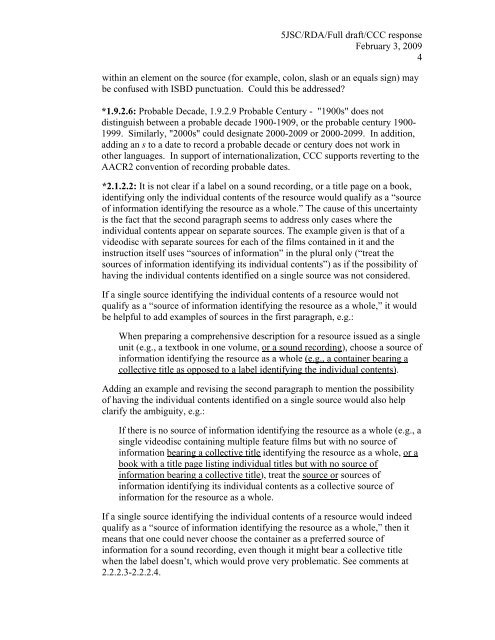

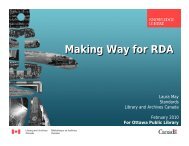
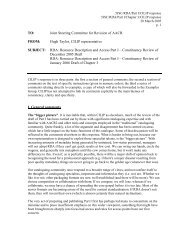
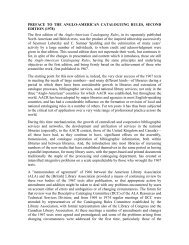
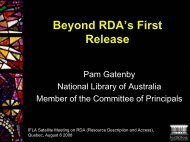

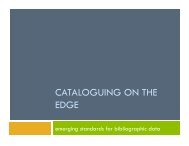

![Presentation slides [PDF] - Joint Steering Committee for ...](https://img.yumpu.com/41621230/1/190x143/presentation-slides-pdf-joint-steering-committee-for-.jpg?quality=85)

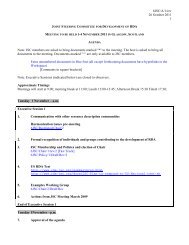
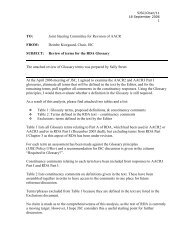
![Presentation slides [PDF] - Joint Steering Committee for ...](https://img.yumpu.com/35256207/1/190x143/presentation-slides-pdf-joint-steering-committee-for-.jpg?quality=85)
